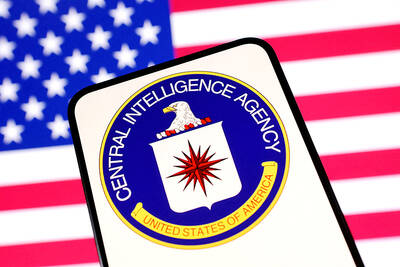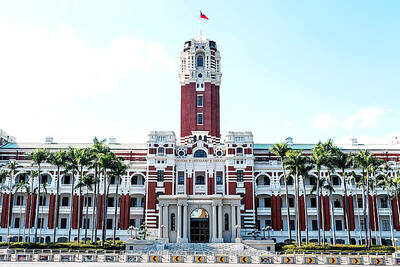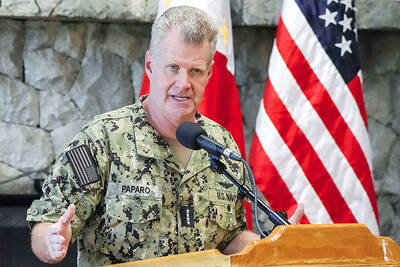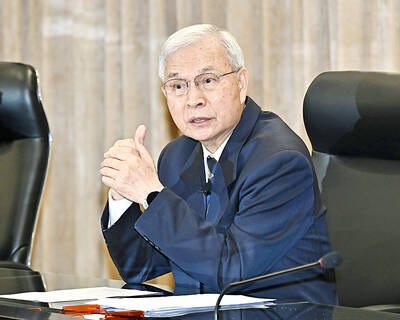US President George W. Bush urged Chinese President Hu Jintao (胡錦濤) in a telephone conversation on Wednesday to use Taiwan's presidential election to take positive actions to peacefully resolve cross-strait tensions, the White House said.
In response, Hu indicated a willingness to reopen cross-strait talks on the basis of the so-called "1992 consensus," which stipulates that both sides concede separate interpretations of the "one China" policy. The "consensus" is not universally recognized as valid in Taiwan. Chinese Nationalist Party (KMT) Legislator Su Chi (蘇起) admitted in 2006 that he had invented the term before the transfer of power to the Democratic Progressive Party (DPP) in 2000.
The Taiwan issue was part of a broader discussion touching on the crisis and violent Chinese crackdown in Tibet, and the embarrassing US Air Force mistake in shipping secret nuclear intercontinental ballistic missile triggers to Taiwan, which the Pentagon admitted on Tuesday.
"On Taiwan, the president said that this weekend's election provides a fresh opportunity for both sides to reach out and engage one another in peacefully resolving their differences," a White house press release said.
Top Bush administration officials said that the Taiwanese election was one of the "triggers" for Bush's call to Hu, in addition to the other US-China issues.
"The Taiwanese election presents an opportunity to encourage China to reach out to Taiwan and to try and resolve differences," Bush's national security adviser Stephen Hadley said.
"And the president did not want to let that go by. And the election, of course, was just this last weekend," he said.
One of the things "that struck me" about the conversation, Hadley said, was that Hu "said that it is China's consistent stand that the Chinese mainland [sic] and Taiwan should restore consultation and talks on the basis of the `1992 consensus,' which sees both sides recognize there is only one China but agree to differ on its definition."
He added: "The interesting thing is whether this is an indication or a signal of a willingness to open dialogue on a basis that, in previous years, had been accepted by both parties. That was very ... pretty interesting."
Hadley described the telephone call as "a serious conversation on really all of the issues," including Taiwan, between Washington and Beijing.
Bush "wanted to ... use the relationship he's built up with President Hu over time to raise these issues and speak very clearly and frankly with him about them. And it was a very good exchange," Hadley said.
Bush's urging of a cross-strait dialogue echoes a statement he made on Saturday in congratulating president-elect Ma Ying-jeou (馬英九) on his election victory, and indicates that Bush hopes that with the departure of President Chen Shui-bian (陳水扁), chances for cross-strait dialogue that can reduce tensions and limit potential US military exposure will be enhanced.
In his congratulatory statement, Bush said: "It falls to Taiwan and Beijing to build the essential foundations for peace and stability by pursuing dialogue through all available means."
"I believe the elections provide a fresh opportunity for both sides to reach out and engage one another in peacefully resolving their differences," Bush said.
Continued from page 1
Meanwhile, China's foreign ministry released a statement about the Bush-Hu talks that focused on Taiwan and repeated much of what Washington said.
The statement, reported by the Chinese government-controlled news service Xinhua, quoted Hu as telling Bush "it is China's consistent stand that the Chinese mainland [sic] and Taiwan should restore consultation and talks on the basis of the `1992 consensus.'"
Xinhua said Hu also expressed "appreciation" to the US for its so-called "one China policy," and "opposing" Taiwanese independence, last week's referendum on UN membership and Taiwan's bids to join international organizations which require members to have statehood.
When asked for comment, KMT Legislator Ting Shou-chung (丁守中) said Hu's proposal to resume cross-strait negotiations on the basis of the "1992 consensus" would be beneficial to Taiwan, because both sides of the Taiwan Strait would be able to maintain ambiguity to interpret what "one China" means.
The DPP legislative caucus said yesterday that accepting the so-called "1992 consensus" would be the beginning of the end for Taiwan's democracy.
"From `accepting the 1992 consensus' to `signing a peace agreement' to `eventual unification.' These would be the three steps that ruin Taiwan's democracy," DPP legislative caucus whip Yeh Yi-ching (葉宜津) said.
DPP Legislator Chai Trong-rong (蔡同榮) said that the changeable nature of the Beijing government was his main concern.
"You never know what they are thinking. They can be your friends today, but hate you tomorrow," Chai said.
Ma yesterday declined to interpret Hu's comments to Bush as a reflection of the Chinese government's "good intentions."
"I need more information about their conversation before commenting further. However, the 1992 consensus is a basis for cross-strait negotiation that has been accepted by both sides," he said. Additional reporting by Flora Wang, Mo Yan-chih and Jimmy Chuang

The CIA has a message for Chinese government officials worried about their place in Chinese President Xi Jinping’s (習近平) government: Come work with us. The agency released two Mandarin-language videos on social media on Thursday inviting disgruntled officials to contact the CIA. The recruitment videos posted on YouTube and X racked up more than 5 million views combined in their first day. The outreach comes as CIA Director John Ratcliffe has vowed to boost the agency’s use of intelligence from human sources and its focus on China, which has recently targeted US officials with its own espionage operations. The videos are “aimed at

STEADFAST FRIEND: The bills encourage increased Taiwan-US engagement and address China’s distortion of UN Resolution 2758 to isolate Taiwan internationally The Presidential Office yesterday thanked the US House of Representatives for unanimously passing two Taiwan-related bills highlighting its solid support for Taiwan’s democracy and global participation, and for deepening bilateral relations. One of the bills, the Taiwan Assurance Implementation Act, requires the US Department of State to periodically review its guidelines for engagement with Taiwan, and report to the US Congress on the guidelines and plans to lift self-imposed limitations on US-Taiwan engagement. The other bill is the Taiwan International Solidarity Act, which clarifies that UN Resolution 2758 does not address the issue of the representation of Taiwan or its people in

US Indo-Pacific Commander Admiral Samuel Paparo on Friday expressed concern over the rate at which China is diversifying its military exercises, the Financial Times (FT) reported on Saturday. “The rates of change on the depth and breadth of their exercises is the one non-linear effect that I’ve seen in the last year that wakes me up at night or keeps me up at night,” Paparo was quoted by FT as saying while attending the annual Sedona Forum at the McCain Institute in Arizona. Paparo also expressed concern over the speed with which China was expanding its military. While the US

SHIFT: Taiwan’s better-than-expected first-quarter GDP and signs of weakness in the US have driven global capital back to emerging markets, the central bank head said The central bank yesterday blamed market speculation for the steep rise in the local currency, and urged exporters and financial institutions to stay calm and stop panic sell-offs to avoid hurting their own profitability. The nation’s top monetary policymaker said that it would step in, if necessary, to maintain order and stability in the foreign exchange market. The remarks came as the NT dollar yesterday closed up NT$0.919 to NT$30.145 against the US dollar in Taipei trading, after rising as high as NT$29.59 in intraday trading. The local currency has surged 5.85 percent against the greenback over the past two sessions, central